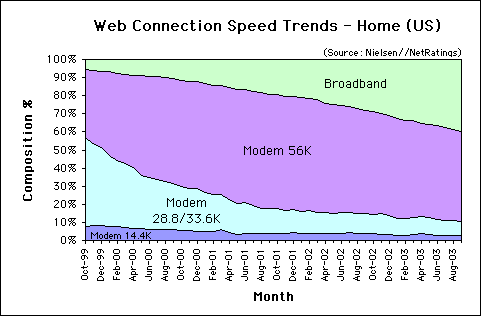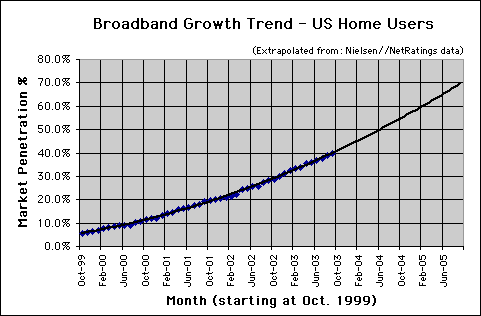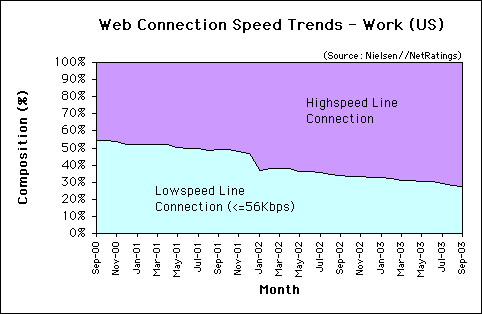Overall, broadband grew by 1.09 percentage points in September, with 40% of US home users enjoying a high-speed connection. 60% of US home users dial into the Internet with “narrowband” connections of 56Kbps or less. Across the pond, Britains endure phone-line splitting by major telcos.
The charts below, derived from Nielsen//NetRatings, show trends in connection speeds to the Internet for users in the United States.*
Home Connectivity in the US
As of September 2003, most users in the US connect to the Internet using dial-up modems of 56Kbps or less. 49.7% use 56Kbps modems, 7.5% use 28/33.3Kbps, and 2.8% use 14.4Kbps modems. In total, 60% of home users in the US connect to the Internet at 56Kbps or less (see Figure 1).
Web Connection Speed Trends – Home Users (US)
Figure 1: Web Connection Speed Trends – Home Users (US)
Source: Nielsen//NetRatings
Broadband Growth in the US
Broadband penetration in US homes increased by 1.09 percentage points in September. As of September 2003 broadband penetration was at 40%, up from 38.9% in August. This is higher than the average increase in broadband of 0.72 percentage points per month from October 1999 to August 2003. Extrapolating the data provided by Nielsen//NetRatings, broadband share in the US should exceed 50% by June of 2004 (see Figure 2).
Broadband Connection Speed Trend – Home Users (US)
Figure 2: Broadband Connection Speed Trend – Home Users (US)
Extrapolated from Nielsen//NetRatings data
Work Connectivity
Most workers in the US enjoy high-speed connections to the Internet. Most use a high-speed line such as a T1 connection, and share bandwidth between computers connected to an ethernet network. The speed of each connection decreases as more employees hook up to the LAN. As of September of 2003, of those connected to the Internet, 72.8% of US users at work enjoy a high-speed connection, up 0.6% from 72.2% in August. 27.2% connect from work at 56Kbps or less (see Figure 3).
Web Connection Speed Trends – Work Users (US)
Figure 3: Web Connection Speed Trends – Work Users (US)
Source: Nielsen//NetRatings
British Telecom Splits the Difference
A reader in Britain writes that the statistics for home users in the UK is further muddied due to British Telecom’s practice of splitting phone lines. Before he switched to broadband, Garry Heaton suffered from line splitting in the UK when BT connected another phone within the same building. “Instead of connecting a new line, often an existing line is ‘split’ which results in a 56K connection being effectively capped at 33K. There are many UK dial-up users affected by this, most of whom are unaware of it and simply experience the Internet slower on their computer.”
“The practice involves the installation of a DACS box when a new phone connection is requested within a building which has an existing BT line. The DACS box allows the existing line to be split, at which point the effective bandwidth is capped at 33Kbps. In practice this can mean a drop to 28K as available bandwidth isn’t always maximised. Cable users are not affected by the practice.”
DACS (Digital Access Carrier System) converts two analog lines into one digital signal, allowing two customers to send data through a single phone line. According to Oftel’s guidelines on Internet access, BT and Kingston Communications are required to provide a telephone connection “capable of functional Internet access” upon reasonable request. Oftel’s guidelines set a benchmark speed of 28.8Kbps for a standard telephone line.
Further Reading
- British Telecom
- BTOpenWorld
- BT’s IT department
- Kingston Communications
- Net access comes as standard
- BBC story on Oftel’s new dial-up guidelines
- Oftel FAQ
- Includes speed guidelines
*Note: “Users” signifies people connected to the Internet.
The Bandwidth Report is featured monthly on URLwire – news of useful and unique web content since 1994.



